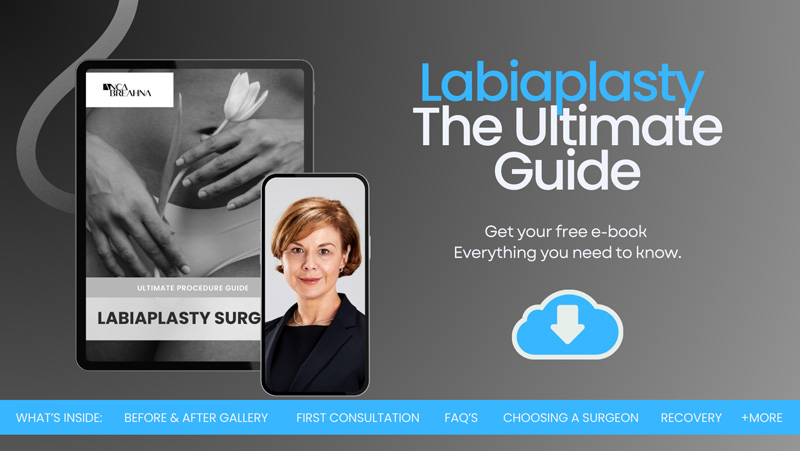
Table of Contents
- Timeline for Recovery after Labiaplasty Surgery
- Download Anca Breahna’s Labiaplasty Guide
- Types of Labiaplasty Surgery and How They Can Affect the Timeline for Recovery
- Trim Procedure
- Wedge Procedure
- Extended Wedge Procedure
- De-epithelialisation Procedure
- Clitoral Hood Reduction
- Labia Majora Augmentation or Reduction
- Pre-Surgery Preparation
- Immediate Post-Operative Phase (Day 1 to Day 7)
- Day 1-3
- Day 4-7
- Early Recovery Phase (Week 2 to Week 4)
- Week 2
- Week 3-4
- Late Recovery Phase (Week 5 to Week 8)
- Week 5-6
- Week 7-8
- Post 8 Weeks
- Long-term Care after Labiaplasty
- Potential Complications during Labiaplasty Recovery
- Bleeding and Haematoma Formation
- Infection
- Delayed Wound Healing or Wound Separation
- Scarring and Changes in Skin Sensation
- Asymmetry or Unsatisfactory Aesthetic Outcome
- Chronic Dryness or Discomfort
- Altered Sensation
- How to Avoid Complications after Labiaplasty
- FAQs about Labiaplasty Recovery
- Further Reading about Procedures at Cheshire Cosmetic Surgery
Timeline for Recovery after Labiaplasty Surgery
Labiaplasty, a surgical procedure aimed at altering the labia minora and/or labia majora, the folds of skin surrounding the human vulva, has become increasingly popular in recent years. This operation is often sought by women seeking relief from discomfort caused by labial hypertrophy or for aesthetic reasons. The timeline for recovery after labiaplasty is important for patients to set realistic expectations and prepare adequately.
In this blog, Chester Consultant Plastic Surgeon Anca Breahna outlines the stages of recovery, offering insights into what patients can anticipate in the days and weeks following the surgery.
Download Anca Breahna’s Labiaplasty Guide

Types of Labiaplasty Surgery and How They Can Affect the Timeline for Recovery
Trim Procedure
- The most common type of labiaplasty, the trim procedure involves trimming the excess labial tissue along the edge of the labia minora. It’s often chosen by women who have concerns about the elongated edges of their labia
- Recovery Impact: This technique may result in a relatively straightforward recovery process. The linear incision typically heals well, but there may be a higher sensation of discomfort or sensitivity along the incision line initially
Wedge Procedure
- This technique involves removing a wedge-shaped piece of tissue from the labia minora while keeping the natural border intact. It’s preferred for maintaining a more natural edge appearance
- Recovery Impact: The wedge procedure might result in a slightly more complex recovery due to the nature of the incisions and suturing. Swelling and discomfort can be more pronounced, and there may be a slightly higher risk of complications like wound separation
Extended Wedge Procedure
- This is a variation of the wedge technique that extends into the labia majora or clitoral hood for a more comprehensive reshaping
- Recovery Impact: The extended nature of this procedure can lead to a longer and more complex recovery period. The larger area of alteration may increase the risk of complications and prolong the healing process
De-epithelialisation Procedure
- This technique involves removing the outer layers of skin from the labia while leaving the underlying tissues intact. It’s less common and typically used for specific cases
- Recovery Impact: Recovery from de-epithelialisation can be variable. While there is less risk of altering the labial contour significantly, the healing of the skin layers can be sensitive and may require careful management
Clitoral Hood Reduction
- This procedure is often performed in conjunction with labiaplasty and involves reducing excess skin around the clitoral hood to improve symmetry and aesthetics
- Recovery Impact: Adding a clitoral hood reduction can extend the recovery period and may add to the complexity of post-operative care. Swelling and discomfort in the clitoral area can be more significant
Labia Majora Augmentation or Reduction
- This involves either reducing the size of the labia majora or augmenting them, usually with fat grafting
- Recovery Impact: The recovery from labia majora procedures depends on whether tissue is being removed or added. Liposuction can result in bruising and swelling, while fat grafting may have a more significant recovery due to the dual sites involved (harvesting and grafting)
Pre-Surgery Preparation
Before the surgery, it’s important to have a thorough consultation with Anca. This discussion should cover your goals, the specifics of the procedure, potential risks, and the recovery process. Preparing your body for surgery is also important. This may involve following specific dietary guidelines, avoiding certain medications, and arranging for assistance during the initial days post-surgery.
Immediate Post-Operative Phase (Day 1 to Day 7)

The first week is critical in the recovery process, with the focus on managing pain, preventing infection, and starting the healing process.
Day 1-3
- Pain Management: Pain is usually most intense during the first few days. Anca will prescribe pain relief medication, which should be taken as directed
- Rest and Limited Movement: It’s essential to rest in bed as much as possible. Avoid any strenuous activities or movements that could put pressure on the surgical area
- Swelling and Bruising: Expect significant swelling and bruising. Applying ice packs can help, but be sure to follow your surgeon’s instructions on how to do this safely
Day 4-7
- Reduced Pain: Pain and discomfort should gradually decrease. If pain persists or worsens, contact Anca’s team
- Hygiene Care: Keeping the area clean is crucial for preventing infection. Follow your surgeon’s advice on cleaning and shower the area after each time you are using the toilet
- Gradual Increase in Activity: You may start to move around a bit more, but continue to rest as much as possible and avoid sexual activity, tampon use, rigorous exercise and driving
Early Recovery Phase (Week 2 to Week 4)
During this phase, you’ll notice a significant improvement in comfort and mobility.
Week 2
- Decreasing Swelling and Bruising: Swelling and bruising should start to subside noticeably
- Possible Return to Work: Depending on the nature of your job, you might feel comfortable enough to return to work
- Post-operative Check-up: A follow-up appointment is usually scheduled to ensure proper healing
Week 3-4
- Continued Healing: The labia continue to heal, and dissolvable stitches will gradually fall off
- Resuming Some Activities: You might be able to resume light exercises, but avoid high-impact activities
Late Recovery Phase (Week 5 to Week 8)
By this stage, most of the healing has occurred, though subtle changes will still happen.
Week 5-6
- Resumption of Normal Activities: By the end of week 6 you can usually return to most of your normal activities, including more strenuous exercises
- Appearance: The final shape and appearance of the labia are becoming more evident, though some minor swelling may persist
- Sexual Activity: Depending on Anca’s advice, you may be able to resume sexual activities towards the end of this phase
Week 7-8
- Full Recovery: Most patients are fully recovered by this stage
- Final Results: The final results of the surgery are visible, although it can take up to six months for all swelling to subside completely and the final outcome to be fully realised
Post 8 Weeks
After eight weeks, most of the major healing has occurred. However, it’s important to continue monitoring your progress. Attend all scheduled follow-up appointments and report any concerns or unusual symptoms to your plastic surgeon.
Long-term Care after Labiaplasty
- Regular Check-ups: Even after you’ve fully recovered, regular check-ups are important
- Scar Management: If you have concerns about scarring, discuss them with Anca. She may recommend certain creams or treatments to help minimise the appearance of scars
- Sensitivity Changes: Some changes in sensitivity are normal and should be discussed during follow-up appointments
Potential Complications during Labiaplasty Recovery
As with any surgical procedure, there are potential risks and complications that can arise during the recovery period. Being aware of these potential issues is important for patients to ensure a smoother recovery process. Here are some complications that could occur during recovery after labiaplasty surgery:
Bleeding and Haematoma Formation
- Bleeding is a risk with any surgery. In the case of labiaplasty, excessive bleeding during or after the procedure can lead to the formation of a haematoma, a collection of blood outside of blood vessels
- Management: Minor bleeding is normal, but significant bleeding may require medical intervention. Haematomas might need to be drained by Anca
Infection
- The risk of infection is present in any surgical procedure. Given the labia’s proximity to the anus and the urinary tract, labiaplasty may have a slightly increased risk
- Signs: Redness, swelling, worsening pain, and discharge can be signs of infection
- Management: Infections are usually treated with antibiotics and require close monitoring. Keeping the area clean is crucial for preventing infection. Follow your surgeon’s advice on cleaning and shower the area after each time you are using the toilet
Delayed Wound Healing or Wound Separation
- The incisions made during labiaplasty may sometimes take longer to heal or may separate, particularly if subjected to tension or excessive movement
- Management: Wound care as per Anca’s instructions is crucial. In some cases, additional medical treatment or revision surgery may be necessary
Scarring and Changes in Skin Sensation
- Scarring is an inevitable part of any surgical procedure. In labiaplasty, scars are usually well-concealed but can sometimes be prominent or cause changes in sensation
- Management: Most scars fade over time. If scarring is a concern, treatments such as laser therapy or steroid injections may be considered
Asymmetry or Unsatisfactory Aesthetic Outcome
- There’s always a risk that the results may not meet the patient’s expectations in terms of appearance or symmetry
- Management: If asymmetry is significant or the aesthetic outcome is unsatisfactory, revision surgery might be an option
Chronic Dryness or Discomfort
- Some women may experience chronic dryness or discomfort in the labial area after surgery, which can be due to nerve damage or changes in the anatomy
- Management: Lubricants can be used for dryness, and discomfort usually diminishes over time. In persistent cases, medical advice is necessary
Altered Sensation
- Temporary or, in rare cases, permanent changes in sensation can occur, including increased sensitivity or numbness
- Management: Most sensory changes are temporary and resolve as the nerves heal. Persistent changes should be discussed with Anca
How to Avoid Complications after Labiaplasty
- Pre-Surgery: Choose a qualified and experienced surgeon and follow all pre-operative instructions
- Post-Surgery Care: Adhere strictly to post-operative care instructions, including wound care, activity restrictions, and hygiene practices
- Monitoring: Keep a close eye on the surgical site for any signs of complications and attend all follow-up appointments
- Communication: Stay in regular contact with your plastic surgeon, especially if you notice any concerning symptoms
FAQs about Labiaplasty Recovery

Why would someone get a labiaplasty?
Individuals opt for labiaplasty for a variety of reasons, both functional and aesthetic. Functionally, women may experience discomfort, irritation, or pain during activities like exercise, sexual intercourse, or even when wearing tight clothing, due to enlarged or asymmetrical labia minora. Aesthetically, some women may feel self-conscious about the appearance of their labia, which can impact their self-esteem and sexual confidence. Labiaplasty offers a solution by resizing or reshaping the labia minora to alleviate physical discomfort and enhance the genital appearance.
Is labiaplasty really painful?
The experience of pain varies from person to person, but labiaplasty is generally performed under anaesthesia, which means there is no pain during the procedure itself. Post-surgery, patients may experience discomfort, swelling, and tenderness in the treated area, but these symptoms are manageable with prescribed pain medication. Most women report that the pain is less intense than they anticipated, and it usually subsides significantly within the first week. It’s important to follow Anca’s post-operative care instructions to minimise discomfort and aid in the healing process.
How bad is labiaplasty recovery?
The recovery process after labiaplasty is usually straightforward, but it does require some downtime and careful management. Patients usually experience swelling and discomfort in the initial days following the surgery, which gradually improves. Most can return to normal activities within a week, although complete healing takes approximately 4-6 weeks. It’s important to avoid physically intense activities and follow Anca’s guidelines to ensure a smooth recovery. While recovery experiences can vary, most patients find it manageable and are satisfied with the outcomes of the procedure.
How successful is labiaplasty?
Labiaplasty is generally considered a highly successful procedure with a high rate of patient satisfaction. Success is measured not only in terms of the aesthetic outcome but also in the alleviation of discomfort and improvement in quality of life. Most patients report significant satisfaction with the results, including reduced irritation and pain, as well as increased confidence and comfort in their bodies. As with any surgical procedure, the success of labiaplasty depends on several factors, including the skill of the surgeon, the patient’s adherence to post-operative care instructions, and individual healing processes.
Is it hard to walk after labiaplasty?
Walking may be uncomfortable in the immediate days following labiaplasty, primarily due to swelling and tenderness in the surgical area. But light walking is actually encouraged soon after the procedure to promote blood circulation and prevent blood clots. Most patients find that they can walk comfortably within a few days post-surgery, although it’s important to avoid strenuous activities and long distances until fully healed. The degree of discomfort varies among individuals, but following Anca’s advice on pain management and recovery can greatly ease the process of walking and resuming normal activities.
Medical References about Labiaplasty Surgery
- What is a labiaplasty and what does it involve? – ASPS
- Vaginal Plastic Surgery: Vaginoplasty and Labiaplasty – WebMD
- Labiaplasty: Surgery, Recovery & What To Expect – Cleveland Clinic
- Recovery after labiaplasty: Timeline and aftercare
- What to expect at every stage of your labiaplasty – ASPS
Further Reading about Procedures at Cheshire Cosmetic Surgery
- Read more about Labial Hypertrophy – Enlarged Labia
- Read more about Labiaplasty
- Read more about Aqualyx (Fat Dissolving Injections)
- Read more about Desirial Injections (Vaginal Dryness)
- Read more about Scars after Labiaplasty
- Read more about Labiaplasty Types – Trim Labiaplasty and Wedge Labiaplasty or Hybrid
- Read more about 10 Questions to Ask Your Surgeon before Labiaplasty Surgery
- Read more about Vaginal Rejuvenation after Pregnancy: An Overview of Options and Benefits






